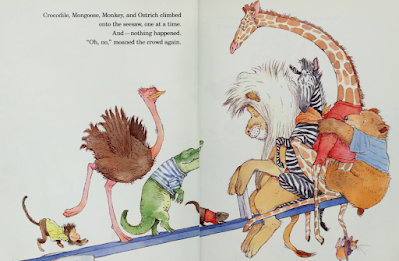Trouble is a children's book by Jane Kurtz, with art by Durga Bernhard, published in 1997. It is not available at the Internet Archive, but there is a YouTube read-along by the author!
After two cranky posts about Benjamin Elkin's appropriation of African folktales while providing no acknowledgement of his sources, I am so pleased to write about this beautiful book which provides abundant information about how this story came to be, along with artwork that is far more culturally responsive than the art in Elkin's books. Children's book publishing has come a long way in the 30 years that separate Kurtz's book from Elkin's.
In the detailed author's note, Kurtz explains that she heard this story about the boy and his gebeta board when she was growing up in Ethiopia. She also notes that Courlander collected a version of this story in Eritrea (back in the 1940s, when it was still part of Ethiopia; see this post), so based on that, she decided to set her version of the story in Eritrea. In addition to the author's note, there is a glossary of the words used in the story that might not be familiar to Anglo readers: dik-dik, gebeta, injera, mashella, and masinko, along with the meaning of the name of her protagonist, the boy she named Tekleh.
The book has been published not just in English but also in several eastern African languages: Amharic, Tigrinya, Swahili and Oromo. How cool is that? Listen to the end of the video when the author's sister, who lives and works in eastern Africa, reads the start of the story in Amharic (with an American accent, as she freely admits!).
In Kurtz's version of the folktale, which starts out very similar to the version that Courlander heard in the 1940s but then goes in a new direction, a man makes a gebeta board for his son to try to keep him out of trouble. When Tekleh meets a camel caravan, the traders complain that there is no wood in that country to make a fire, and when Tekleh insists there is wood and shows them his gebeta board, they throw it into the fire. In compensation, they give him a knife. A hunter needs a knife to skin a dik-dik, and Tekleh trades the knife for a masinko (musical instrument). He meets some musicians on their way to a wedding feast and trades the masinko for a drum, and follows them to the wedding where he snatches some food. He then plays his drum for a farmer (the noise keeps birds and monkeys away), who rewards him with corn. Then he gives the drum to the farmer for a papaya. He meets a woman whose children are hungry and gives them the corn and the papaya. One of the children gives him a gebeta board, and when he returns home, his father says, "Did I not tell you? A gebeta board never fails to keep a young boy out of a trouble."
As you can see, this is a story of trades more than a story of compensation; in Courlander's story, and in Elkin's version also, people break or lose the object that the boy gives them, so they cannot return it to him and must give him some kind of compensation. (This compensation story is found in trickster versions also; I'll have examples of those to share later.) In Kurtz's story, however, Tekleh is very good-hearted and kind, and in the end he even gives the corn and papaya to the hungry family without even thinking of something in return... which is when, in fact, he gets back the gebeta board he lost in the fire to begin with. I've marked this as a "compensation" type of story because it starts off that way, but it really is more of a generic "trading" type of chain tale — not trading-up or trading-down because, ultimately, it is trading in a circle!
Although there is not an illustrator's note (that is my ideal: an author's note AND an illustrator's note!), the book jacket explains that Bernhard "teaches West African drum and dance. As research for this book she played the gebeta game with her children and learned to cook Eritrean food." As you can see in the YouTube video, the illustrations are absolutely lovely, far more culturally responsive than the illustrations in Elkin's book.
So, if like me, you are a collector of chain tale books and/or African folktales for children, this is a book you will want to add to your collection!







.jpg)











.jpg)








.jpg)



.jpg)








